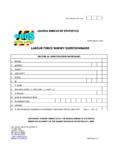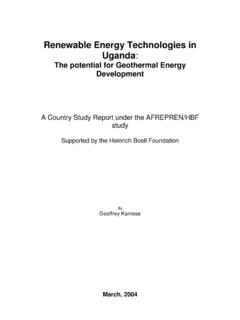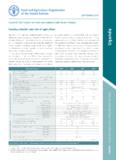Transcription of Republic of Uganda Ministry of Gender Labour and …
1 Republic of Uganda Ministry of Gender Labour and Social Development A WORLD FIT FOR children national progress report 2006 _____ A World Fit For children national progress report 2006 iiTABLE OF CONTENTS TABLE OF CONTENTS ..II ABBREVIATIONS .. III MAJOR ACTIONS TAKEN FOR children AND TOWARDS WFFC SINCE 2002 ..2 POLICY LEVEL LEGISLATIVE SERVICE DELIVERY LEVEL RESOURCE TRENDS FOR CENTRAL GOVERNMENT RECURRENT ! BOOKMARK NOT DEFINED. LOCAL GOVERNMENT EXPENDITURE ON DEVELOPMENT AND USE OF MONITORING INSTRUMENTS TO TRACK WFFC/MDG TARGETS ..10 POVERTY STATUS ANNUAL SECTOR HOUSEHOLD AND DEMOGRAPHIC Uganda HUMAN RIGHTS COMMISSION (UHRC)..11 Ministry OF Gender Labour AND SOCIAL LOCAL GOVERNMENT REPORTING ON IMPLEMENTATION OF INTERNATIONAL HUMAN RIGHTS INSTRUMENTS AND OTHER GOVERNMENT ENHANCING PARTNERSHIPS, ALLIANCES FOR children AND PARTICIPATION.
2 12 PARTNERSHIPS AND PARTICIPATION OF ACHIEVEMENT OF WFFC PLAN OF ACTION AND RELATED MDG TARGETS ..15 PROMOTING HEALTHY Reduction in Infant and Child mortality ..16 Reduction in Maternal Mortality ..17 Reduction in percentage of households without access to water, hygienic sanitation facilities and safe PROVIDING QUALITY Achieving Universal Primary Education ..18 : Eliminating Gender disparity in primary and secondary education ..20 PROTECTION AGAINST ABUSE, EXPLOITATION AND Child abuse and violence against children ..21 Impact of Armed Sexual Exploitation ..22 Child COMBATING SUMMARY OF LESSONS LEARNED AND INITIATIVES UNDERTAKEN SINCE 2002 FOR ACCELERATING THE progress ..26 PROMOTING HEALTHY PROMOTING QUALITY COMBATING HIV/AIDS.
3 28 PROTECTING children FROM ABUSE, EXPLOITATION AND REFERENCES ..29 _____ A World Fit For children national progress report 2006 iiiABBREVIATIONS AIDS Acquired Immune Deficiency Syndrome ANC Ante Natal Care CBO Community Based Organisation CEDAW Convention on Elimination of All Forms of Discrimination Against Women CRC Convention on the Rights of the Child CSO Civil Society Organisations FBO Faith Based Organisation GDP Gross Domestic Product GoU Government of Uganda HIPC Highly Indebted Poor Countries HIV Human Immuno-deficiency Virus HSSP Health Sector Strategic Plan ICC International Criminal Court IDP Internally Displaced Persons IMR Infant Mortality rate KDP Karamoja Development Programme LG Local
4 Government LGDP Local Government Development Programme LRA Lords Resistance Army MDG Millennium Development Goals MGLSD Ministry of Gender Labour and Social Development MMR Maternal Mortality Rate NPPA national Priority Programme Areas NUSAF Northern Uganda Social Action Fund PAF Poverty Alleviation Fund PEAP Poverty Eradication Action Plan PSR Poverty Status report SCiU Save the children in Uganda UBOS Uganda Bureau of Statistics UCRNN Uganda Child Rights NGO Network UN United Nations UNDP United Nations Development Programme _____ A World Fit For children national progress report 2006 ivUNICEF United Nations children s Fund UNHS Uganda national Household Survey UNICEF United Nations children s Fund UNPAC Uganda national Plan of Action for children UPE Universal Primary Education UPPAP Uganda Participatory Poverty Assessment Process UPPET Universal Post Primary Education Training WFFC World Fit For children WFP World Food Programme _____ A World Fit For children national progress report 2006 INTRODUCTION Uganda has ratified the international human rights instruments including the UN Convention on the Rights the Child (CRC) and its Optional Protocols (on sale of children , child prostitution and child pornography and involvement of children in armed conflict), and the Convention on Elimination of All Forms of Discrimination Against Women (CEDAW).
5 Uganda also ratified African Charter on Rights and Welfare of the Child, a regional instrument promoting rights and responsibilities of children . In the same vein Uganda was among the countries that made a commitment to the Plan of Action of A World Fit for children 1 and is therefore obliged to periodically review progress made towards the goals and strategies for children . The 2002 Population Census estimated Uganda s total population at with an annual growth of , ranked third highest in the world after Niger and Yemen. Population projections for 2005 mid-year, the total number of children aged less than 18 years was million and expected to rise to million by 2010. Of the total number of children in Uganda , about 41% live in poor households and of the million Ugandans below the poverty line by 2003, 60% or million were children below 18 years an unproportionately high representation of children among the poor and approximately 13% of children are orphans (UBOS 2005).
6 Furthermore, an estimated million children and women are living with the effects of conflict mainly in the Northern districts in addition to around 240,000 refugees as a result of other conflicts beyond Uganda borders. Eradicating poverty is the major development goal of the government of Uganda for which it developed a Poverty Eradication Action Plan (PEAP) in 1997. The 1999 2002 Uganda national Plan of Action for children (UNPAC) has now been integrated in the revised PEAP (2004/05 2007/08). The 3 year rolling plan provides the national framework to address the Millennium Development goals, and most of the WFFC commitments. Most of the MDGs related to health, education, HIV/AIDS and the protection of internally displaced persons are contained under pillars 3, 4, and 5 of the PEAP.
7 There are however substantial differences in the quantitative targets to be achieved between the MDGs and PEAP as will be shown in progress summary tables in the later sections of this report . Since 2002, Government has put in place specific policy measures and interventions to respond to issues impacting on children and this is reflected in the substantive progress made in formulating a number of social policy frameworks, the decentralized systems of 1 A World Fit For children (WFFC) is one in which all children get the best possible start in life and have access to quality basic education and in which all children have ample opportunity to develop their individual capacities in a safe and supportive environment.
8 _____ A World Fit For children national progress report 2006 2governance and establishing and or improving on existing legal frameworks. The interventions targeting children have in principal been tailored towards specific age groups and largely rural based as the majority of children live in rural areas. This report is a review of progress towards the goals of the WFFC. While this report will contribute to the UN Secretary General s report to the General Assembly, it also serves as a self assessment for Uganda to determine how far it has progressed in as far as WFFC goals are concerned and indeed on the fulfillment of children s rights. Identification of challenges and constraints will further guide re-prioritization for children .
9 The report has been prepared in close consultation with the civil society and development partners. While Uganda has made significant progress towards meeting some of the MDG/WFFC targets with a possibility of attaining them before the deadlines, especially those relating to poverty, UPE and HIV/AIDS, it is performing poorly on others. Of serious concern is the fact that infant and child mortality has been on the increase, malaria continues to be the most important cause of morbidity and mortality among children , malnutrition affects a significant proportion of the children and poverty remains high among children2. Meeting the PEAP, MDG and WFFC targets will necessitate government and all its development partners paying closer attention and finding solutions to bridge the gap between the conducive policy environment in place, and full implementation through increased resource allocation, enhanced efficiency, commitment and ensuring adequate capacities for accelerated implementation at all levels.
10 MAJOR ACTIONS TAKEN FOR children AND TOWARDS WFFC SINCE 2002 Policy level actions Government of Uganda (GoU) has put in place policies and legislative framework which provide an enabling environment for observance of children s rights. This commitment is embodied in the PEAP goals for poverty eradication ( Uganda s Poverty Reduction Strategy Paper, PRSP), the national Gender policy, the Uganda Food and Nutrition policy, Orphans and vulnerable children Policy and the related national strategic Programme Plan of Interventions for OVCs, national Youth Policy, Elimination of Child Labour Policy, national Gender Policy and policy on the handling of street children . Government also launched the Internally Displaced Persons Policy (August 2004), the Uganda national HIV and AIDS Policy among others.















